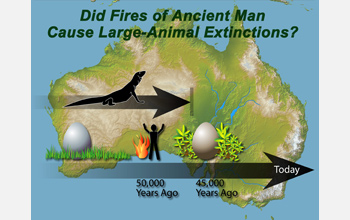Multimedia Gallery
Did Fires Cause Large Extinctions?
By measuring radioactive carbon isotopes in fossilized eggshells, researchers found more evidence that man's extensive use of fire, which resulted in a dramatic change in the ecosystem, accounted for the massive animal extinctions in Australia some 50,000 years ago. The reconstructed, 140,000-year dietary record for two flightless birds showed they switched from nutritional grasses to desert scrub for forage, which coincided with the arrival of humans to the continent and not with a climate change.
Consequently, animals like the emu that were more tolerant of dietary changes survived, while more-specialized feeders perished. The massive demise resulted in the extinction of 85 percent of Australia's largest mammals, reptiles and birds--creatures that included 19 types of marsupials or kangaroo-like animals, a 25-foot-long snake, a 25-foot-long lizard and a tortoise the size of a small car.
This image accompanied NSF press release, "When Down Under Went Up in Smoke."
Credit: Nicolle Rager Fuller, National Science Foundation
Images and other media in the National Science Foundation Multimedia Gallery are available for use in print and electronic material by NSF employees, members of the media, university staff, teachers and the general public. All media in the gallery are intended for personal, educational and nonprofit/non-commercial use only.
Images credited to the National Science Foundation, a federal agency, are in the public domain. The images were created by employees of the United States Government as part of their official duties or prepared by contractors as "works for hire" for NSF. You may freely use NSF-credited images and, at your discretion, credit NSF with a "Courtesy: National Science Foundation" notation.
Additional information about general usage can be found in Conditions.
Also Available:
Download the high-resolution JPG version of the image. (993 KB)
Use your mouse to right-click (Mac users may need to Ctrl-click) the link above and choose the option that will save the file or target to your computer.



